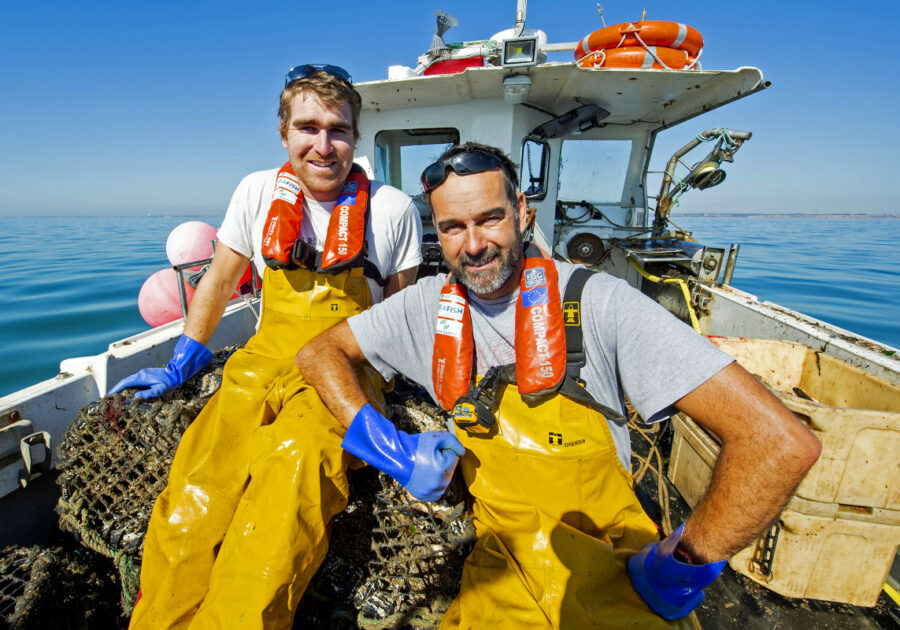Dorset fisherman Peter Dadds welcomed John Periam and Geoffrey Lee to Mudeford Quay recently, to share his experiences of inshore fishing
Mudeford Quay is situated on the Dorset coast near the entrance to Christchurch harbour, with stunning views across to the Isle of Wight. It is made up of two areas, one being the quay itself and the other being Mudeford Spit, a natural sandbank leading to Hengistbury Head and along to Bournemouth.
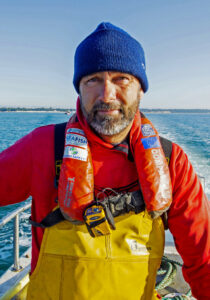
Peter Dadds wearing a Mullion Compact 150 lifejacket and an Ocean Signal RescueMe PLB1.
Needless to say, the area is popular with tourists, especially in the summer months.
Fishing has always played an important part within the local community, with eight boats currently fishing from here.
Mudeford RNLI lifeboat is situated on the quay, giving it direct access into the Solent.
Dorset fishermen are particularly proud of the South Coast Fishermen’s Council, established 40 years ago. Members from along the coast meet on a regular basis with the many organisations involved in the fishing industry, including the Southern Inshore Fisheries and Conservation Authority (SIFCA).
‘Needless to say, the area is popular with tourists, especially in the summer months’
“Peter really is one of the good guys who continue the fine tradition of inshore fishermen and lifeboatmen,” said SIFCA chief fishery officer Robert Clark.
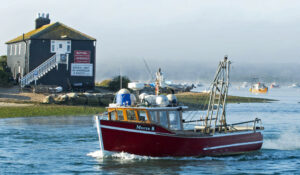
Mister B leaving Mudeford Quay. Now deregistered, the boat continues to be owned by retired fisherman Barry Childs (known as Mr B), who patrols the harbour as Mudeford’s water bailiff.
“The South Coast Fishermen’s Council works hard to make sure fishermen are aware of the requirements of running sustainable fisheries. There has been a lot of interest from other regions in how we operate. Peter helps in promoting this, and along with others he plays an important part in what we do,” said Stella Dean MBE, who is the council’s secretary and treasurer.
Early days
Peter’s father, also called Peter, is a wooden boat builder on Mudeford Quay, and because of this, Peter’s interest started at a young age, with opportunities to go to sea, crewing on other boats.
“You could say that when I left school, I started my career in fishing the next day. I was one of the last ones to do the Youth Training Scheme at Cornwall, which was run by Sid Porter, and this was followed by four blocks of five weeks each at Falmouth.
“There was another person called – if I remember – Cliff Pender, who became one of my mentors, and taught me so much. I was one of the youngest on the course, and worked on a much smaller boat than the others. It was a great learning curve, concluded by a week in Hull. I learnt so much.”
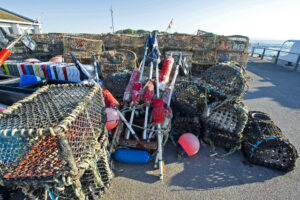
Crab and lobster ‘prison parlour pots’, made by Monteum Ltd of Shoreham.
Peter continued to gain as much experience as he could, by working on many different types of boats, with some of the best.
“I had always wanted my own boat, but felt I had to learn as much as I could about fishing and safety at sea before I invested in one.
“In the good days, my dad knew every Mudeford fisherman, and helped them out with their boat repairs. Mudeford was a small and respected fishing community, and we supported each other. My first boat was an old 20ft open wooden launch, and I paid the sum of £840 for it. This was in the days before licences. She was built in 1948, and she was pretty ‘tired’ when I got her in 1991. Thanks to my dad, we almost rebuilt her – he was a perfectionist. Licensing then came out, and I couldn’t get one. Dad appealed, and I got it.
“I started off with eight strings of five pots, and a mate of mine joined me and we fished 150 pots between us. I then went into a joint venture with another fisherman, but after a year decided to move on. It was a learning curve for me about working with others and boat types.
“I saw an advert for an old Cheetah catamaran, and popped over to the Isle of Wight, and it was love at first sight.

Taking pot bait onboard the Cheetah Marine catamaran Chloe and Christie PE 18 at Mudeford Quay.
I never went out on a sea trial. It was fibreglass, and looked great. As a wooden boat builder, my dad could never come to terms with the word ‘fibreglass’!”
This catamaran was the first Cheetah Sean Strevens built, and it had been his own. There was a great deal of interest in its design, and it turned out to be the start of Sean’s career as a boatbuilder, and of the development of Cheetah Marine as an international company.
Peter kept this boat for four years, and called it ‘Cheetah’.
“I had visions of grandeur, and replaced it with a 36ft wooden boat. In brief, it was a disaster. I spent more time in the engineroom than I did fishing.”
‘I saw an advert for an old Cheetah catamaran, and popped over to the Isle of Wight, and it was love at first sight’
A passing conversation with a visitor to Mudeford resulted in that boat’s sale. He had a Cheetah cat for sale, and once again, it was love at first sight. “£10,000 later, I had the boat, and called her Déjà Vu. She was a great little boat – 6.2m in size, and excellent in all weathers. I also made some modifications, including a little ramp at the back. I had her until 2004.”
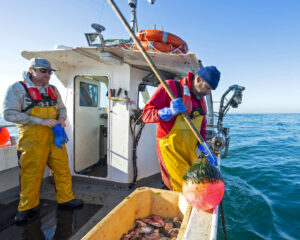
Peter takes the end aboard.
Peter’s current boat, which he purchased in 2006, is a Cheetah 6.9, also called Déjà Vu. Most of the time, Peter works single-handed – other than in the winter, when he likes to have another crewmember onboard.
Capsize
Peter took Déjà Vu out of the water shortly before Christmas 2017 to do some maintenance work, before starting to work around 120 pots.
“I learnt from experience in 2014, when out of 180 pots, 120 were lost and 55 were severely damaged, leaving me with only five pots.”
On the day Déjà Vu capsized, Peter Dadds and Martin Hawk left Mudeford Quay with a forecast of SW 4 to 5 decreasing 3, with a 2m swell.
“That morning, Martin and I decided to switch roles. He operated the pot hauler, and I worked at the stern of the boat. It was a very strong spring tide, but we were able to handle things.
“We decided to just do 10 strings and return to Mudeford. I went to the wheelhouse to get a bucket with my bits and bobs in, so I could repair a damaged pot.

Peter Dadds clearing a pot…
“Out of the corner of my eye, I noticed the pot was stuck on the gunnel. I glanced up and saw a wave the size of an industrial unit coming at us. We were on a shallow patch, some 15ft deep. I increased the engine power and turned hard to starboard, throwing the pots over the side. By the time I had done that, the bow was down by about 60%, and there was 10ft of white foaming water above us, breaking either side of the boat.”
That was it. Peter cannot remember any more, other than lots of noise and being underwater. His PFD operated, and he came up to the surface to see his Cheetah some 40ft away from him, upside down, and the sea covered in white foam.
“It was a surreal moment to see the boat upside down, and then Martin popped up and managed to clamber onto the bow, where he knelt in the tunnel. I managed to swim over and clamber up to join him. He then asked if I was fine, but referred to a nasty gash in my head. We were wet, cold and shaken.
“I have fished these waters for 30 years, and had never seen a swell like it. What was interesting was that both our ears had popped.
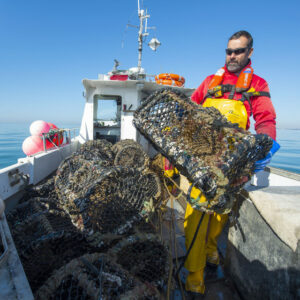
… before stacking it aft ready for reshooting.
“Speaking to the coastguard later, they said that to do that, the swell must have been in excess of 5 to 6m. Not having the depth of water underneath us was the cause of it all. There were other boats out there, but we could not see each other.
“The Cheetah hull has 14 watertight bulkheads, and it was due to the quality of this build that we did not sink. We were on the hull for four hours, and I gathered at the time that some of the other boats suffered gear damage.
“All our communication equipment and flares were in the wheelhouse, but it happened so quickly we could not get to them. It was the lifejacket that saved me. Martin, who was stuck in the wheelhouse, was saved by not having his lifejacket on. Had he been wearing it, he would have been trapped as it self-inflated, restricting any movement.
“Richard Stride, who is the lifeboat operations manager, had just returned in his fishing boat, but at the time was unaware of the incident. A small sailing boat saw us, and it came over and immediately contacted the coastguard and lifeboat. They came out straight away and took both of us in, then returned to tow Déjà Vu in.

Matt and Peter have worked together for nine years.
“There is no doubt the Cheetah saved our lives, and it is currently being repaired.”
Sean Strevens of Cheetah Marine said: “Having fished lobster pots for 10 years south of the Isle of Wight, I know how dangerous a big groundswell in very shallow water can be, especially with strings of pots, where the back line or pot gets hung in on the seabed. As a designer, I have always been very keen on reserve buoyancy and sealed compartments. To keep the boat afloat in this situation is critical.”
Peter Dadds continued, “At the moment, I am crewing with another fellow fisherman, Matt Wiles, who also has a Cheetah. He has been wonderful, and helped retrieve as much of my gear as we could. It took a while for me to restore my confidence. I am a helmsman on the Mudeford lifeboat, but I decided to take a short break to take

Martin Hawk, who survived the capsize incident with Peter Dadds, always wears a Mullion Compact 150 lifejacket and an Ocean Signal RescueMe PLB1 when fishing.
stock of the situation.
“The eight boats operating from Mudeford mostly fish for shellfish. However, due to the current situation we net, pot and trap as well as doing some rod and line fishing. It is not a great time for us inshore fishermen at the moment. I won’t mention Brexit, and currently have little faith in its outcome.
“The Fishermen’s Association here is so important for us all, and we are aware of how much it works for us all.
“We also owe a lot to Robert Clark, Southern IFCA’s CFO. He is a wonderful person, and what you see is what you get. He protects us and makes sure that we have access to all the other governing bodies at our regular meetings. He was one of the first to call me after I lost the boat.”
The Mudeford RNLI lifeboat has only two fishermen on its current crew – this is largely due to the fact that they have to spend more time at sea due to the current regulations. It is an Atlantic 85, and is called Mudeford Servant. Richard Stride, the operations manager, has been fishing from Mudeford for a long time, keeping the name of Stride to the fore in the region’s fishing communities.
The capsize made Peter reflect on his life and family.
“It certainly did knock the stuffing out of me, and I locked myself away for a week. I was black and blue. If I had not gone back to sea to rescue my gear, things might be different. I am still not 100%, but my confidence has returned. I owe a lot to my wife Jo, who was a wonderful support. She is also press officer for the lifeboat, and was at the station when the incident was reported, only to find out it was my Cheetah that was involved.
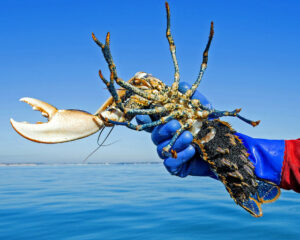
Peter Dadds prepares to return a berried hen lobster to the sea, in line with the landing ban DEFRA brought in 12 months ago.
“The insurance company was great, and did not hinder me in any way, and I owe a big thank you to Anne at Morgan Marine for her support. There is no doubt that keeping the right paperwork on file did help a lot. There will be some extra costs in getting Déjà Vu repaired, but it will be well worth it.
“I just hope that there is a future for the fishing industry – the current political situation is causing some restless nights for us all. Fishing is my life, and I love it!
“I have a very supportive family, with my wife Jo, two sons Miles and Harrison, and daughter Maisie – this incident has made me reflect on them all, had I not returned.
“My experience helped, along with having the right safety equipment on board. Ultimately, the design and build quality of the Cheetah catamaran got us through.
“Every day is a learning curve, and it is nice to know we have the support of the Maritime Coastguard, RNLI, fellow fishermen, and organisations like the Fishermen’s Mission when things take a turn for the worst.”

